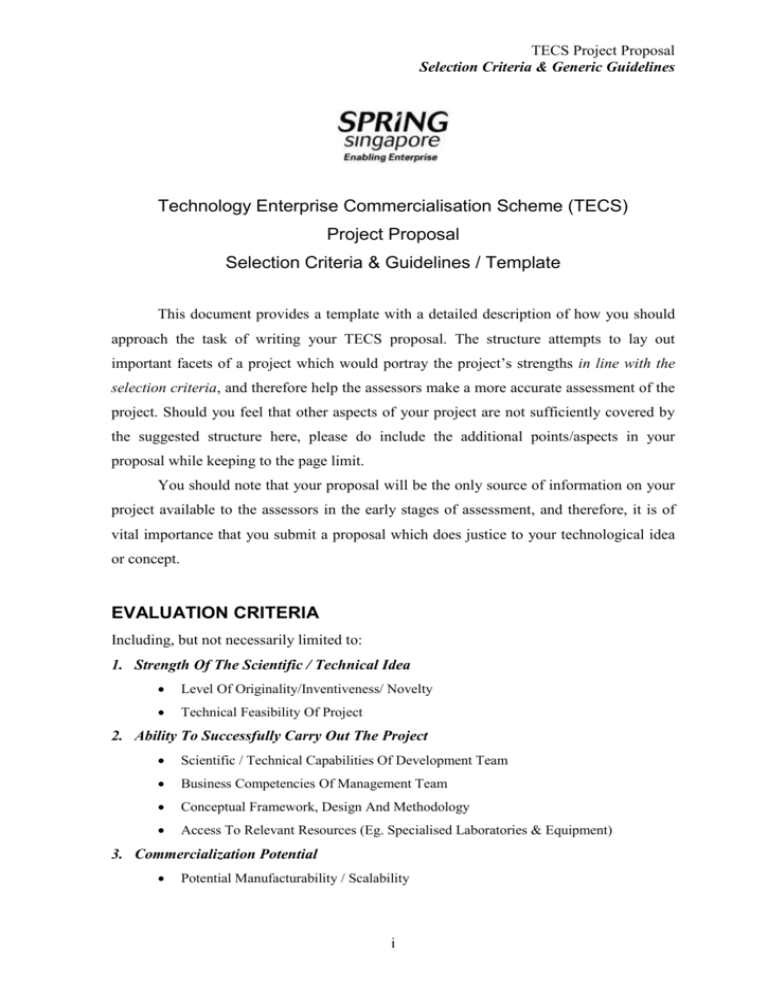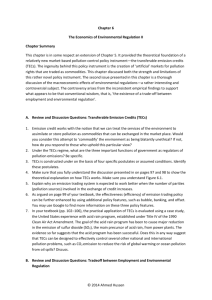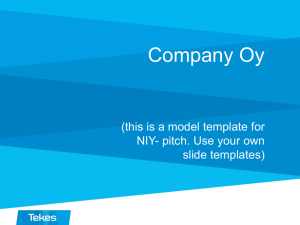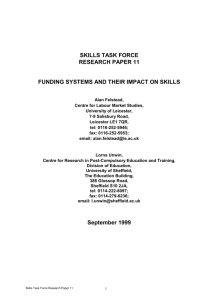TECS Project Proposal Template & Guidelines
advertisement

TECS Project Proposal Selection Criteria & Generic Guidelines Technology Enterprise Commercialisation Scheme (TECS) Project Proposal Selection Criteria & Guidelines / Template This document provides a template with a detailed description of how you should approach the task of writing your TECS proposal. The structure attempts to lay out important facets of a project which would portray the project’s strengths in line with the selection criteria, and therefore help the assessors make a more accurate assessment of the project. Should you feel that other aspects of your project are not sufficiently covered by the suggested structure here, please do include the additional points/aspects in your proposal while keeping to the page limit. You should note that your proposal will be the only source of information on your project available to the assessors in the early stages of assessment, and therefore, it is of vital importance that you submit a proposal which does justice to your technological idea or concept. EVALUATION CRITERIA Including, but not necessarily limited to: 1. Strength Of The Scientific / Technical Idea Level Of Originality/Inventiveness/ Novelty Technical Feasibility Of Project 2. Ability To Successfully Carry Out The Project Scientific / Technical Capabilities Of Development Team Business Competencies Of Management Team Conceptual Framework, Design And Methodology Access To Relevant Resources (Eg. Specialised Laboratories & Equipment) 3. Commercialization Potential Potential Manufacturability / Scalability i TECS Project Proposal Selection Criteria & Generic Guidelines Potential To Attract Further Funding & Market Demand Defensibility Of Intellectual Property 4. Economic Benefits To Singapore GENERIC GUIDELINES Page Limit & Pagination: Your main write-up should not exceed 20 pages (not including the cover page, references, and supporting enclosures/attachments). The total number of pages inclusive of supporting documents must not exceed 35 pages. Begin numbering your pages after the cover page (at the executive summary page). References and supporting enclosures/attachments may be numbered separately with roman numerals (i, ii, iii, iv, etc). Page Setting: The proposal should be done on A4 page size setting, with page borders not less than 1.2” on the left and 1” on all other sides. Font: Please use Times New Roman font, no smaller than Font size 12. ii TECS Project Proposal Template Technology Enterprise Commercialisation Scheme Project Proposal Optional graphics / pictures / company logo where appropriate Project Title Name of Company/Principal Investigator Project Start & End Dates Proposal Written By: Writer’s Name / Designation Organisation Cover Page – No Pagination TECS Project Proposal Template EXECUTIVE SUMMARY (1 page) The Executive Summary should be brief and cover the major ideas in the proposal, both scientific and commercial. It is suggested that the summary be written last. Avoid creating a summary by simply “cutting and pasting” sections from the body of your proposal, or concentrating only on the problem and technological solution of your project. Instead, carefully map out the salient points of your proposal which would address the selection criteria as holistically as possible. Please organise your summary as follows: 1. Need / Opportunity/Demand Drivers: In no more than 150 words, summarise the background problem / challenges that your proposal will solve. Highlight the target market size and customer opportunities. 2. Technical Solution: In no more than 200 words, provide a gist of the solution that you are proposing. Highlight the key technology innovation to be developed as part of this project, and how it’s done differently from competitors. Emphasise potential patent filings, if any. 3. Application / business model: In no more than 200 words, what is your business model and go-to market strategy? Share why your proposed product is disruptive to the market, and what your competitive advantage is. Highlight any partners / contacts which you have access to. 4. Team: In no more than 100 words, briefly describe the technical and business capability of the team in executing the proposed project. Pg 1 of 8 TECS Project Proposal Template PROPOSAL NARRATIVE – MAIN TEXT (Max 20 pages) In order to present a complete picture of your proposal, it is strongly recommended that the main text includes the following sections in the proposed sequence but is not necessarily limited to them in content. 1. Company Profile (~ 1 page) This should be a brief summary of the company’s background, core business, competency in the area, and track record of technology commercialisation, if and where applicable. The idea is to give assessors a background ‘feel’ of the company’s position. Detailed descriptions of existing company products/services, sales turnover, overseas business, existing customer profiles, existing facilities/infrastructure or affiliated companies can be provided as an overview under ‘supporting enclosures / attachments’. Company should elaborate on prior funding/incentive/grant1 that has been used to develop the background technology. Company has to state other funding/incentive/grant that they have obtained, or are in the midst of application/obtaining. 2. Detailed POC / POV Project Description (~ 3 – 6 pages) First, describe what you are trying to achieve in your project in the context of a Proof-OfConcept or Proof-Of-Value. This would require you to start with: Explaining what stage of development your proprietary IP, concept or idea is at, and Describing your overall and end-state objective of getting the TECS grant. Describe the technology concept to be proven. Please elaborate on the: Scientific / technological concept and approach of the project. Please provide technical details and elaborate on the developmental tasks to be undertaken, sample drawings (for ICT proposals, please include architectural 1 Examples of funding/incentive/grant are NRF-POC grants, Singapore-MIT Alliance for Research & Technology (SMART) grant, A*STAR COT/flagship funding, NRF-TIS incubation funding, SPRING SEEDS investment or any Early Stage Venture Funding Pg 2 of 8 TECS Project Proposal Template diagrams), process flows, other engineering / scientific explanations. The scientific/technological approach can either be completely novel, or a novel integration of existing or new technologies. Projects with potentially transformational scientific/technological concepts would be the most competitive. A transformational scientific/technological concept is one that would potentially bring about disruptive changes to current methods and the current market. Key innovations of the proposal - highlight the uniqueness of your approach and research goals. Significance of the scientific / technical innovations. How do the innovations solve the problem or improve significantly on current methods? Overall impact of project. This includes the potential for the idea to be commercialised, the potential economic spin-offs and market value, disruptive potential to the market, etc. Please note that TECS does not support the following: incremental or predictable next step in the improvement of existing technology a simple combination of current technologies in a new format setting up of manufacturing lines 3. Novelty of Proposed Approach & Product In Relation to Competitors (~ 0.5 – 1.5 page) This section can be broadly divided into two parts. Where applicable, please provide: a description of how the proposed Approach compares with alternative approaches being pursued (or previously pursued) by competitors or even by your own organization; a description of how the resultant Technological IP compares with other competitors’ products or solutions that have been developed, commercialised or sold. On alternative approaches, cite any related or similar efforts that may have been unsuccessful and clearly describe how your approach avoids or overcomes those pitfalls. Pg 3 of 8 TECS Project Proposal Template For the latter, identify any competing solutions and products and explain how and why your resultant technological IP or product has the potential to better address the problem, or better yet, addresses problems which competitors cannot. Identify any competing solutions and products and explain how and why your resultant technological IP or product has the potential to better address the problem, or better yet, addresses problems which competitors cannot. A direct comparison of relevant key quantitative performance metrics must be used to illustrate the transformational improvement of your product: EXAMPLE: Table of Relevant Key Performance Metrics Products Proposed Competitor A Competitor B Competitor C Metrics Technology Product Product Product Performance 10 x/ml 5 x/ml 4 x/ml 6 x/ml Metric X Performance $1.20 /m2 $2.30 /m2 $1.60 /m2 $1.90 /m2 Metric Y *This is a simplified example; you might choose the relevant and useful quantitative metrics to be included 4. Barriers of Entry & Defensibility (~ 0.5 page) Not to be confused with intellectual property protection, barriers of entry typically include such aspects as proprietary knowledge, technology, or data, and any other strong element of a product or process which makes replication difficult for competitors. 5. IP Situation / Strategy (~ 1 page) Briefly explain the IP landscape studies done on similar IPs to identify potential IP infringements that require cross-licensing and how you can address these issues. If background IP/licenses is to be used, please provide the patent details (Patent/PCT filing number) as well as details of the licensing agreements (royalties, exclusivity, geography) if they have been signed under ‘supporting enclosures/attachments’. Is there any Freedomto-Operate study done? An IP strategy is not only a list of patents and patent applications, but a proactive plan to ensure that the background and foreground IP is protected from infringement and that any Pg 4 of 8 TECS Project Proposal Template infringements are appropriately dealt with, so that the start-up/company will safely benefit from the IP. The preparation of an IP strategy often involves legal consultation and usually comprises plans for a patent portfolio and how the portfolio relates to planned business goals, plans for patent procurement and management, and even how the patent is to be used (licensing) and defended (litigation). 6. Commercialisation Plans (~ 2 – 4 pages) Detail your commercialisation plans in the event of successful completion of the project. This must include the prospective business model, key growth drivers, marketing and sales strategy, and elaboration on aspects such as manufacturability and scalability. The proposal should include details such as the costs involved in manufacturing or in the case where the manufacturing is to be outsourced, identify the potential vendor for outsourced manufacturing. Include plans on scalability of the business and the expansion plans both locally and internationally. Also include details such as 5-year financial projections of potential revenue both during the project and post-project till commercialisation. You should also address your project’s potential to attract future funding at various stages of the commercialization outside of POC/POV funding. Identify the amounts required and when/how you plan to obtain these funds, and how these funds are to be used. Provide the capital expenditure plan for the next 5 years. In addition, POV projects must demonstrate interest from a relevant reference customer or a third party investor as a validation of sustainable growth and ability to attract further funding. Companies should start talking to potential customers/users to gather initial interests in the technology innovation to be developed. Please place any relevant letters of intent/involvement in the project under ‘supporting enclosures/attachments’. 7. Benefits and Long-term plans in Singapore (~ 0.5 page) The funding that TECS provides comes from taxpayers and is intended to benefit Singapore. Please highlight the tangible qualitative/quantitative benefits and outcomes to Singapore (e.g. manpower to be hired for project, IP to be generated, collaborations with Pg 5 of 8 TECS Project Proposal Template local institutes). In addition, if your project addresses specific societal and industrial needs or challenges, describe how, relate the function of your project to that need (not simply restating the function of the product). Company should also elaborate on its long-term plans in Singapore (e.g. Anchoring of strategic business functions or value adding activities in Singapore). SPRING reserves the rights to incorporate some of these expected benefits/plans in Singapore as part of the TECS funding offer. 8. Qualifications / Background of Project Team (~ 1 page) A summary of the relevant technical as well as business experience and qualifications must be included for the key team members (including project members to be hired) who will work on your project. If key staff will be hired, describe the qualifications needed for key positions yet to be filled. Note that where a project requires a multidisciplinary approach, the assessors will expect relevant capabilities to be reflected. Concentrate on both the technical and commercial acumens of the team. Resumes with more details (optional) may be placed under ‘supporting enclosures / attachments’. Please highlight the potential hires and skills / capabilities required from the team. 9. Milestones, Deliverables, Timeline & Decision Points (~ 1 – 2 pages) Provide appropriate interim and final key milestones and a timeline with minimum specificity of at least project-months. These key milestones must be realistic, specific, quantifiable, and must relate to technical objectives, targets and success criteria. Whether a milestone has been met must be explicitly answerable with a yes or no. Indicate or provide go/no-go decision points where appropriate. These are decision points linked to quantifiable milestones where a project may be continued, terminated, or modified to adopt an alternative approach. Ideally, the project milestones should include external validation at some point towards the end of the project for test-bedding or trials with potential customers. It is recommended that you tabulate your milestones and use a Gantt chart to depict your timeline as in the following example: Pg 6 of 8 TECS Project Proposal Template EXAMPLE: Table of Milestones & Deliverables & Corresponding Gantt Chart (Timeline) Task Milestone 1 Completion component A of 2 Production of prototype batch 3 Completion First Trial of Deliverable Action By Due Quality X higher than industry standard (Sensitivity of 100ppm) by 200% Demonstration by Test Y No-go: Termination of project if <110% above industry standard. Alternative approach if <150% above industry standard. Completion of pilot batch for trials Company Name 5th Mth Company Name / Contractor Company Name 9th Mth Completed testing/evaluation by external/deployment at end-user site Quality Y to achieve speed of 30 secs (industry standard – 1 min) 12th Mth *This is a summarized example; please give more interim milestones and details in your proposal. Task 1 2 3 1 2 3 4 5 Project Months 6 7 8 9 10 11 12 *This is a simplified example; you might choose to have each month further divided into weeks. 10.Adequacy of Facilities, Equipment & Resources (~ 0.5 page) Briefly describe the research facilities and specialised equipment required for your project, what are already available to you for use, what needs to be obtained or rented, and where. Collaborations or agreements with Centres of Innovation, or research laboratories should also be mentioned. For facilities / equipments that have been concluded for use in the project with your partners such as the research institutes, you may either indicate the stage of development, or provide any letter of engagement under ‘supporting enclosures / attachments’. 11.Budget (~ 0.5 page) Provide a summary of expected costs in bulleted, point form, indicating the overall estimated cost at the end. Eg: “The budget will include: Lease of laboratory space in Singapore Pg 7 of 8 TECS Project Proposal Template 3 new hires in Singapore for the design and testing of prototype X Materials and consumables for production of prototype X and field testing Consultant fee for help with “specialised field/expertise Y Total Estimated Cost: SGD$238,000” Details will have to be included in the ‘cost breakdown’ template, and not here in your proposal. 12.Other Supporting Information & Justifications (Where necessary; ~ 1 page) An example of scenarios where addition justifications must be provided include cases where foreign professional services have to be chartered, or for R&D to be carried out outside of Singapore. REFERENCES (Where applicable; ~ 0.5 page) SUPPORTING ENCLOSURES / ATTACHMENTS It is compulsory for all POV applications to demonstrate interest from a reference customer or a third party investor as a validation of sustainable growth and ability to attract further funding. The corresponding Letter of Intent (LOI) should be placed under this section. Otherwise, only supporting information should be included under enclosures and attachments. Eg. Short resumes/CV of key staff, or other documents supporting the application Although enclosures and attachments are not included in the 20-page limit, do not use this section to ‘pad’ your proposal. Providing an excessive amount of unrelated information does not provide any benefit to an application. The cost breakdown proposal, latest Financial Statements (balance sheets) and ACRA statements are to be uploaded on the TECS application portal separately. Pg 8 of 8








